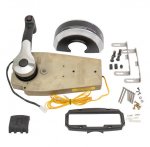Texasmark
Supreme Mariner
- Joined
- Dec 20, 2005
- Messages
- 14,900
On the two red wires, they are different sizes....not in front of me so I can't give you the AWGs. My bet is that the small one is for housekeeping voltages to the regulator and the other larger one is 0-16A (Red Stator) output for battery charging.
Sam, your picture is ok except on these1998 and later engines there is no separate terminal block....the solenoid stud is the TB.
Looks like we are all in agreement.....battery gets a look first.
Still can't figure out a connection to RPMs and the fuse blowing, unless you are pumping the Up trim switch ensuring trim stays in max up.....to get your expected top speed. Butttt that's just solenoid control current, no way near 20 amps.........."Gremlins".
Sam, your picture is ok except on these1998 and later engines there is no separate terminal block....the solenoid stud is the TB.
Looks like we are all in agreement.....battery gets a look first.
Still can't figure out a connection to RPMs and the fuse blowing, unless you are pumping the Up trim switch ensuring trim stays in max up.....to get your expected top speed. Butttt that's just solenoid control current, no way near 20 amps.........."Gremlins".




















